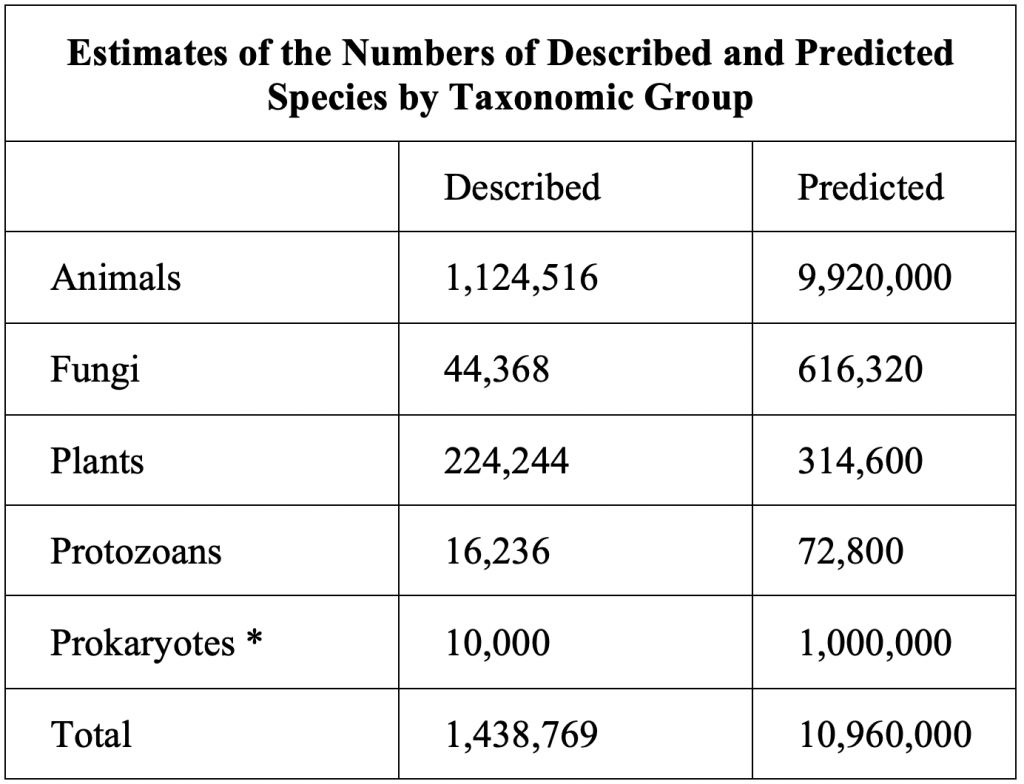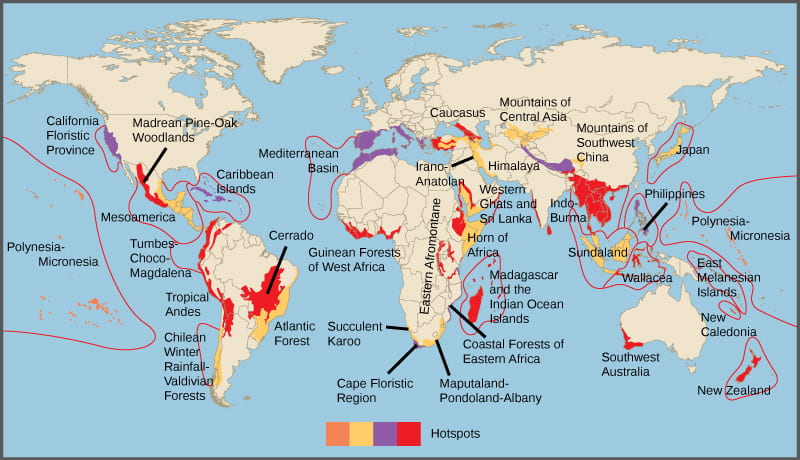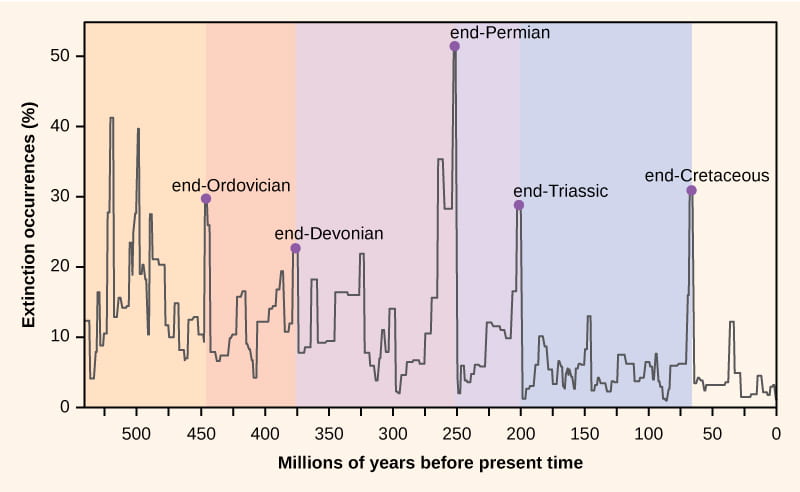Learning Objectives
- Know that extinction is a natural process of the birth and death of species here on earth.
- Explain why the definitive statement that a recently extant species is now extinct is problematic.
- List and describe the major threats to species that are causing extinctions
- Examine your own valuation of living organisms: are a cockroach and a giant panda of equivalent value to survive and thrive? should they be? why or why not?
Extinction is the permanent loss of a species from the planet. Every species arises and goes extinct, in an analogous pattern to the birth and death of individuals. Dr. Joe Mendelson, Director of Research at Zoo Atlanta, puts it another way: extinction is when N = 0. The “unfortunate problem of ‘zero’,” in his words, is that it requires supporting data. What evidence is required to declare a species extinct?
Diversity of described species
From OpenStax Biology 2e.
Despite considerable effort to identify and document species, our knowledge of the number of species that inhabit the planet is limited by lack of financial resources and political willpower. A recent estimate suggests that the eukaryote species for which science has names, about 1.5 million species, account for less than 20 percent of the total number of eukaryote species present on the planet (8.7 million species, by one estimate). Estimates of numbers of prokaryotic species are largely guesses, but biologists agree that science has only begun to catalog their diversity. Even with what is known, there is no central repository of names or samples of the described species; therefore, there is no way to be sure that the 1.5 million descriptions is an accurate accounting. It is a best guess based on the opinions of experts in different taxonomic groups.

The predicted number of species in each taxonomic group greatly exceeds the described numbers of species. Data from Mora et al. 2011. Prokaryote data from Chapman 2009. Image modified from OpenStax Biology 2e.
One of the oldest observed patterns in ecology is that species biodiversity in almost every taxonomic group increases as latitude declines. In other words, biodiversity increases closer to the equator (Figure 47.3).

Figure 47.3 This map illustrates the number of amphibian species across the globe and shows the trend toward higher biodiversity at lower latitudes. A similar pattern is observed for most taxonomic groups. The white areas indicate a lack of data in this particular study. (From OpenStax Biology 2e)
Scientists have many hypotheses and no clear answers to explain this pattern. One factor may be the greater age of the ecosystems in the tropics versus those in temperate regions; the temperate regions were largely devoid of life or were drastically reduced during the last glaciation. The idea is that greater age provides more time for speciation. Another possible explanation is the increased direct energy the tropics receive from the sun versus the decreased intensity of the solar energy that temperate and polar regions receive. Tropical ecosystem complexity may promote speciation by having more unique places for species to live, or perhaps by providing a stable environment without seasons with their winters and short day lengths.
Regardless of the mechanisms, it is certainly true that all levels of biodiversity are greatest in the tropics. Additionally, the rate of endemism—species unique to a defined geographic location, and found nowhere else—is highest, and there are more biodiversity “hotspots.” However, this richness of diversity also means that knowledge of species is unfortunately very low, and there is a high potential for biodiversity loss.
Conservation of Biodiversity
In 1988, British environmentalist Norman Myers developed a conservation concept to identify areas rich in species and at significant risk for species loss: biodiversity hotspots. Biodiversity hotspots are geographical areas that contain high numbers of endemic species. The purpose of the concept was to identify important locations on the planet for conservation efforts, a kind of conservation triage. By protecting hotspots, governments are able to protect a larger number of species. The original criteria for a hotspot included the presence of 1500 or more endemic plant species and 70 percent of the area disturbed by human activity. There are now 34 biodiversity hotspots (Figure 47.4) containing large numbers of endemic species, which include half of Earth’s endemic plants.

Figure 47.4 Conservation International has identified 34 biodiversity hotspots, which cover only 2.3 percent of the Earth’s surface but have endemic to them 42 percent of the terrestrial vertebrate species and 50 percent of the world’s plants. (From OpenStax Biology 2e)
Past Mass Extinctions
The number of species on the planet, or in any geographical area, is the result of an equilibrium of the natural “birth” and “death” processes of speciation and extinction. When speciation rates begin to outstrip extinction rates, the number of species will increase; likewise, the number of species will decrease when extinction rates begin to overtake speciation rates. Throughout Earth’s history, these two processes have fluctuated—sometimes leading to dramatic changes in the number of species on Earth as reflected in the fossil record (Figure 47.5).

Figure 47.4 Conservation International has identified 34 biodiversity hotspots, which cover only 2.3 percent of the Earth’s surface but have endemic to them 42 percent of the terrestrial vertebrate species and 50 percent of the world’s plants. (From OpenStax Biology 2e)
Paleontologists have identified five points in the fossil record that appear to show sudden and dramatic losses in biodiversity. These are called mass extinctions, which we will define as the (geologically) rapid loss of a large number of lineages scattered throughout the tree of life (“pruning” the tree of life). In most cases, the hypothesized causes are still controversial; however, the most recent mass extinction that ended the dinosaurs seems to have a clear cause: asteroid impact smashing into what is now the Yucatan peninsula to alter the global climate for roughly 10 million years.
Recent Extinctions
The sixth, or Holocene, mass extinction is currently ongoing, largely due to the disruptive activities of modern humans. Since the beginning of the Holocene period, there are numerous recent extinctions of individual species that are recorded in human writings. Most of these are coincident with the expansion of the European colonies since the 1500s.
One of the earlier and popularly known examples is the dodo bird. The odd pigeon-like bird lived in the forests of Mauritius (an island in the Indian Ocean) and became extinct around 1662. The dodo was hunted for its meat by sailors and was easy prey because it approached people without fear (the dodo had not evolved with humans). Pigs, rats, and dogs brought to the island by European ships also killed dodo young and eggs.
Steller’s sea cow became extinct in 1768; it was related to the manatee and probably once lived along the northwest coast of North America. Steller’s sea cow was first discovered by Europeans in 1741 and was overhunted for meat and oil so that in just 27 years the species was extinct.
Since 1900, a variety of species have gone extinct, including the passenger pigeon and Carolina parakeet in North America, the Japanese sea lion, and the Caribbean monk seal. Each of these highly visible extinctions was caused by a combination of hunting and habitat destruction by humans. These are only a few of the recorded extinctions in the past 500 years. The International Union for Conservation of Nature (IUCN) keeps a list of extinct and endangered species called the Red List. The list is not complete, but it describes 380 extinct species of vertebrates after 1500 AD, 86 of which were driven extinct by overhunting or overfishing.
In spite of these clear cut examples, documenting a species extinction is practically impossible. Species can live in wild and remote places. How does a biologist know that the frog that lives under rocks in remote Nicaragua is no longer there? Does he turn over every rock simultaneously to show it is not there. Were that possible, would it be a good idea to disrupt the habitat of an endangered species? If it wasn’t already extinct, surely that type of massive habitat disruption would do the trick to kill off the last few survivors.
Major threats to biodiversity and species loss
Habitat Loss
Elimination of a species ecosystem—whether it is a forest, a desert, a grassland, a freshwater estuarine, or a marine environment—will kill the individuals belonging to the species. The species will become extinct if we remove the entire habitat within the range of a species. Human destruction of habitats accelerated in the latter half of the twentieth century. Consider the exceptional biodiversity of Sumatra: it is home to one species of orangutan, a species of critically endangered elephant, and the Sumatran tiger, but half of Sumatra’s forest is now gone. The neighboring island of Borneo, home to the other species of orangutan, has lost a similar area of forest. Forest loss continues in protected areas of Borneo. All three species of orangutan are now listed as endangered by the International Union for Conservation of Nature (IUCN), but they are simply the most visible of thousands of species that will not survive the disappearance of the forests in Sumatra and Borneo. The forests are removed for timber and to plant palm oil plantations . Palm oil is used in many products including food products, cosmetics, and biodiesel in Europe. A five-year estimate of global forest cover loss for the years 2000–2005 was 3.1 percent. In the humid tropics where forest loss is primarily from timber extraction, 272,000 km2 was lost out of a global total of 11,564,000 km2 (or 2.4 percent). In the tropics, these losses certainly also represent the extinction of species because of high levels of endemism.
Overharvesting
Overharvesting is a serious threat to many species, but particularly to marine and freshwater species. Despite regulation and monitoring, there are recent examples of fishery collapse. The collapse of western Atlantic cod fishery is the among the most significant. While it was a hugely productive fishery for 400 years, the introduction of modern factory trawlers in the 1980s caused unsustainable overfishing. Fisheries collapse as a result of both economic and political factors. Fisheries are managed as a shared international resource even when the fishing territory lies within an individual country’s territorial waters. Common resources are subject to an economic pressure known as the tragedy of the commons, in which essentially no fisher has a motivation to exercise restraint in harvesting a fishery when it is not owned by that fisher. The overexploitation is exacerbated when access to the fishery is open and unregulated and when technology gives fishers the ability to overfish.
Coral reefs are extremely diverse marine ecosystems that face immediate peril from several processes. Reefs are home to 1/3 of the world’s marine fish species—about 4,000 species—despite making up only 1 percent of marine habitat. Most home marine aquaria are stocked with wild-caught organisms, not cultured organisms. Although no species is known to have been driven extinct by the pet trade in marine species, there are studies showing that populations of some species have declined in response to harvesting, indicating that the harvest is not sustainable at those levels. There are concerns about the effect of the pet trade on some terrestrial species such as turtles, amphibians, birds, plants, and even the orangutan.
Invasive Species
Exotic species are species that have been intentionally or unintentionally introduced into an ecosystem in which they did not evolve. For example, Kudzu (Pueraria lobata), which is native to Japan, was introduced in the United States in 1876. It was later planted for soil conservation. Problematically, it grows too well in the southeastern United States—up to a foot a day. It is now an invasive pest species and covers over 7 million acres in the southeastern United States. If an introduced species is able to survive in its new habitat, that introduction is now reflected in the observed range of the species. Human transportation of people and goods, including the intentional transport of organisms for trade, has dramatically increased the introduction of species into new ecosystems, sometimes at distances that are well beyond the capacity of the species to ever travel itself and outside the range of the species’ natural predators.
Most exotic species introductions probably fail because of the low number of individuals introduced or poor adaptation to the ecosystem they enter. Some species, however, possess pre-adaptations that can make them especially successful in a new ecosystem. These exotic species become invasive, with dramatic population increases in their new habitat and reset the ecological conditions in the new environment, threatening the species that exist there. Invasive species can threaten other species through competition for resources, predation, or disease.
Lakes and islands are particularly vulnerable to extinction threats from introduced species. In Lake Victoria, the intentional introduction of the Nile perch was largely responsible for the extinction of about 200 species of endemic cichlid fish. The accidental introduction of the brown tree snake via aircraft from the Solomon Islands to Guam in 1950 has led to the extinction of three species of birds and three to five species of reptiles endemic to the island. Several other species are still threatened. Islands do not make up a large area of land on the globe, but they do contain a disproportionate number of endemic species because of their isolation from mainland ancestors.
It now appears that the global decline in amphibian species recognized in the 1990s is, in some part, caused by the fungus Batrachochytrium dendrobatidis, which causes the disease chytridiomycosis. There is evidence that the fungus is native to Africa and may have been spread throughout the world by transport of a commonly used laboratory and pet species: the African clawed toad (Xenopus laevis). It may well be that biologists themselves are responsible for spreading this disease worldwide. The North American bullfrog, Rana catesbeiana, which has also been widely introduced as a food animal but which easily escapes captivity, survives most infections of Batrachochytrium dendrobatidis, and can act as a reservoir for the disease. It also is a voracious predator in freshwater lakes.
Climate Change
Climate change, and specifically the anthropogenic (meaning, caused by humans) warming trend presently escalating, is a major extinction threat, particularly when combined with other threats such as habitat loss and the expansion of disease organisms. While scientists disagree about the likely magnitude of the effects, with extinction rate estimates ranging from 15 percent to 40 percent of species destined for extinction by 2050. Scientists agree that climate change will alter regional climates, including rainfall and snowfall patterns, making habitats less hospitable to the species living in them, in particular, the endemic species. The warming trend will shift colder climates toward the north and south poles, forcing species to move with their adapted climate norms while facing habitat gaps along the way. The shifting ranges will impose new competitive regimes on species as they find themselves in contact with other species not present in their historic range. One such unexpected species contact is the new range overlap between polar bears and grizzly bears (Figure 47.15). There are documented cases of these two species mating and producing viable offspring. Changing climates also throw off species’ delicate timed adaptations to seasonal food resources and breeding times. Many contemporary mismatches to shifts in resource availability and timing have already been documented.

Figure 47.15 Since 2008, grizzly bears (Ursus arctos horribilis) have been spotted farther north than their historic range, a possible consequence of climate change. As a result, grizzly bear habitat now overlaps polar bear (Ursus maritimus) habitat. The two species of bears, which are capable of mating and producing viable offspring, are considered separate “ecological” species because historically they lived in different habitats and never met. However, in 2006 a hunter shot a wild grizzly-polar bear hybrid known as a grolar bear, the first wild hybrid ever found. (Image credit: OpenStax Biology 2e)
Range shifts are already being observed: for example, some European bird species ranges have moved 91 km northward. The same study suggested that the optimal shift based on warming trends was double that distance, suggesting that the populations are not moving quickly enough. Range shifts have also been observed in plants, butterflies, other insects, freshwater fishes, reptiles, and mammals.
Climate gradients will also move up mountains, eventually crowding species higher in altitude and eliminating the habitat for those species adapted to the highest elevations. Some climates will completely disappear. The accelerating rate of warming in the arctic significantly reduces snowfall and the formation of sea ice. Without the ice, species like polar bears cannot successfully hunt seals, which are their only reliable source of food. Sea ice coverage has been decreasing since observations began in the mid-twentieth century, and the rate of decline observed in recent years is far greater than previously predicted.
Finally, global warming will raise ocean levels due to meltwater from glaciers and the greater volume of warmer water. Shorelines will be inundated, reducing island size, which will have an effect on some species, and a number of islands will disappear entirely. Additionally, the gradual melting and subsequent refreezing of the poles, glaciers, and higher elevation mountains—a cycle that has provided freshwater to environments for centuries—will also be jeopardized. This could result in an overabundance of salt water and a shortage of fresh water.
